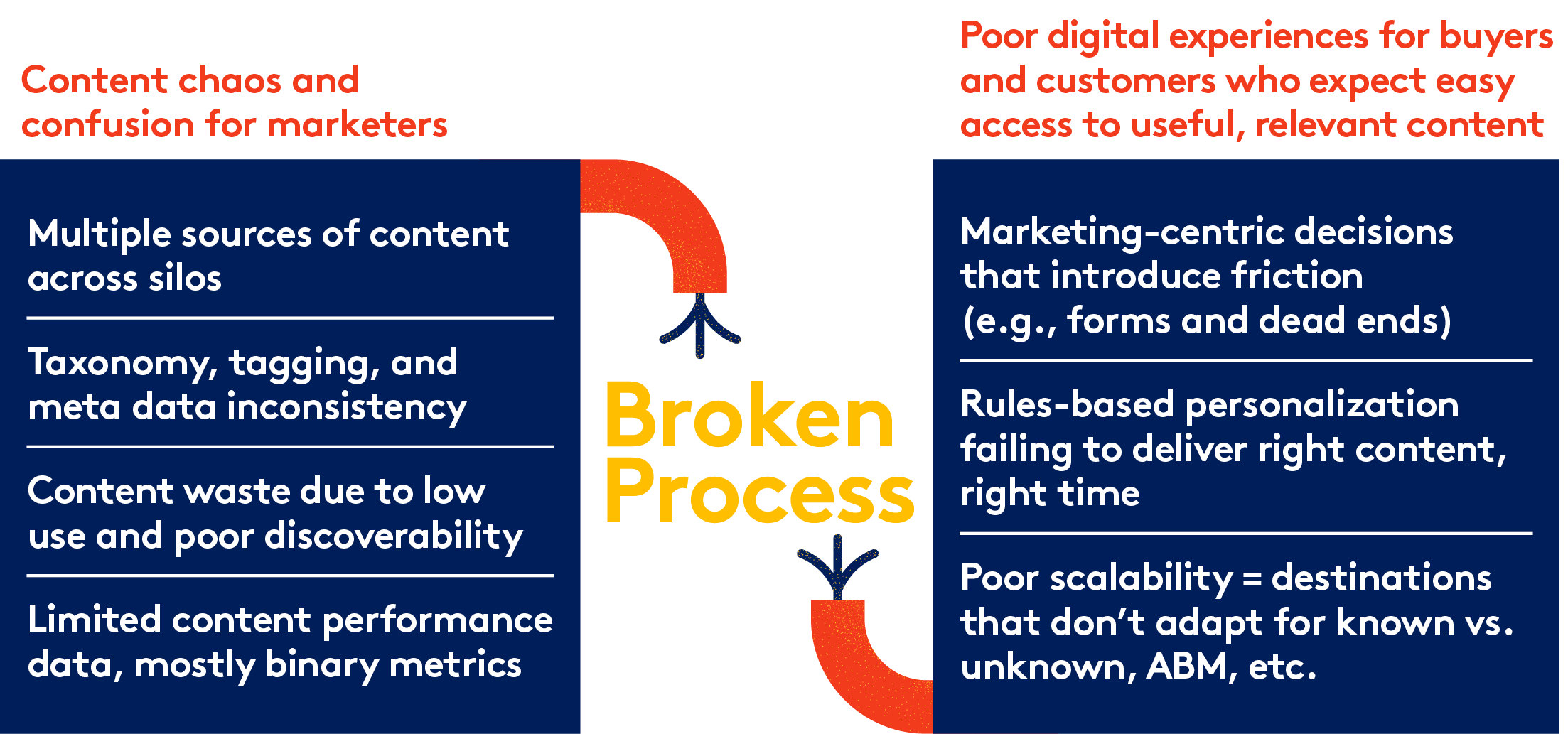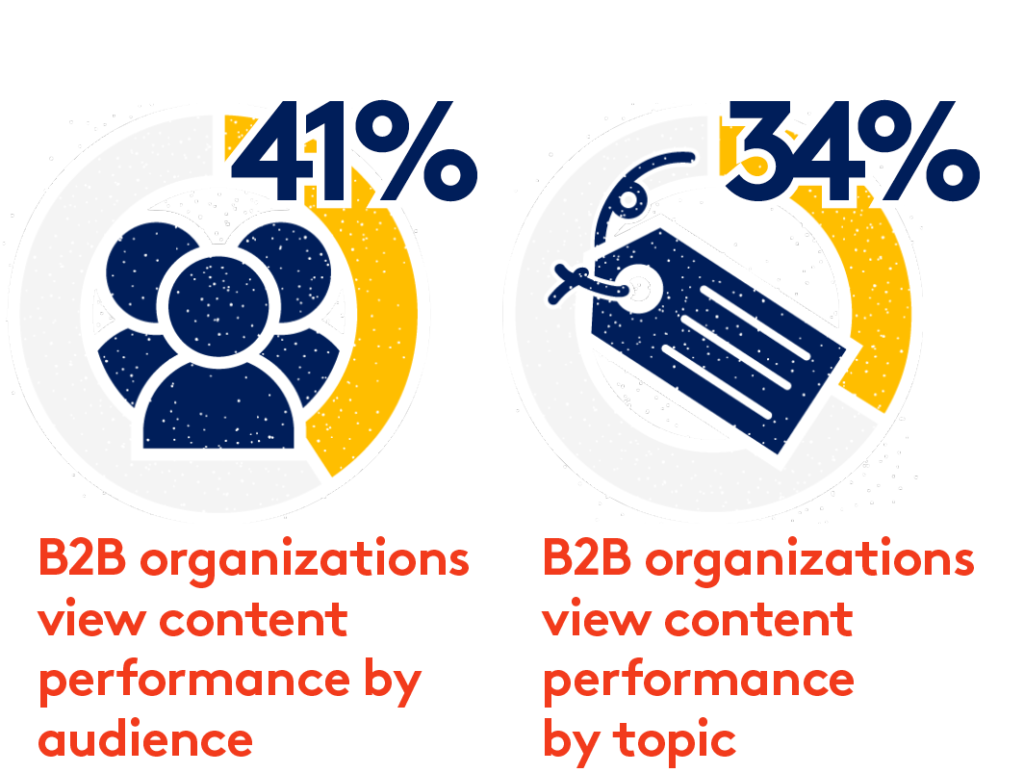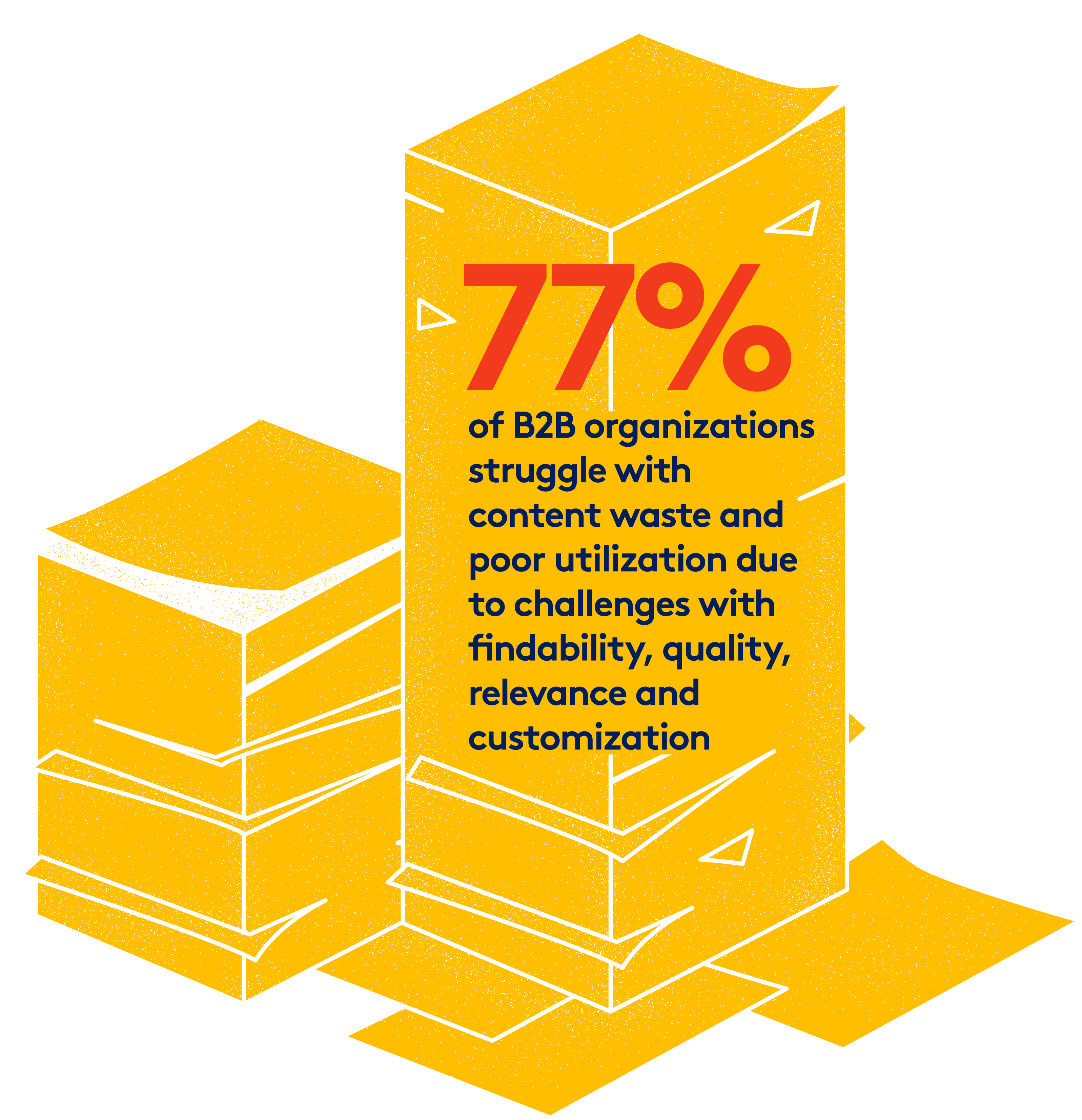
The Broken Process Behind B2B Content
Content is fuel in the B2B buyer’s journey, but tried and true approaches aren’t as effective as they used to be. Here’s why.
Delivering the right content to the right person at the right time is no longer optional for increasing pipeline and revenue — it’s critical. This is especially pertinent with the rapid expansion of buying groups: champions, influencers, decision makers, ratifiers, and end users all require content to address their specific needs at different stages of the journey. Forrester reports that over 80% of purchases now involve complex buying groups, and 63% include at least four people — compared to 47% in 2017. The number of interactions during the purchase process has also increased, rising from an average of 17 in 2019 to 27 in 2021, and it continues to grow.
Marketers have already responded by doubling down on content production — the Content Marketing Institute reports that, on average, 26% of B2B marketing budgets are allocated to content. As a result, buyers are now inundated with content at every touchpoint, and competition for their time and attention has never been more fierce. But quantity isn’t enough — marketers also need to enable prospects to self-direct their own content experiences as they progress through the buyer’s journey. That’s the real competitive advantage.
The bad news is, “tried and true” B2B marketing methods aren’t up to the task. Marketers know they need to deliver a high volume of quality, relevant content to enable prospects to self-educate and progress through the buyer’s journey. But they’re using outdated approaches, broken systems, and clunky content engines to get the job done.

Here are just a few reasons why legacy marketing practices are standing in the way:
B2B buyers are acting like consumers.
Consumer platforms like Netflix and Spotify have normalized instantaneous and unlimited content access, and hyper-relevant, personalized recommendations. This has forced marketers to quickly adapt to the evolving expectations, preferences, and behaviors that B2B buyers now bring with them from their personal lives into every new purchase decision. Salesforce reports that 56% of B2B buyers expect to find whatever they’re looking for on a company’s website in three clicks or less. They become frustrated when the information they need isn’t readily available, or when content that marketers send them isn’t personally relevant or in context with their current relationship phase with a brand.
That’s where things start to break down, and the gap between marketers and their audience widens. According to Forrester, marketing executives cited “understanding customer’s content preferences” as their number-one content-related challenge. Resolving this disconnect will become even more imperative as millennials continue to play an increasingly influential role in buying groups, with 73% now involved in purchase decisions at B2B organizations. As digital natives, they bring even higher standards for effortless content experiences than their predecessors, but too many B2B marketers are missing the mark. According to research from B2B International, 35% of millennials agree that B2B platforms offer a considerably worse customer experience than their B2C counterparts, compared to just 21% of older generations.
Traditional martech stacks emphasize channel performance and visitor volume over content engagement.
Think about a typical martech stack, composed of a CMS, CRM, MAP, and maybe an ABM tool. Content is usually created and deployed through one-and-done, batch-and-blast experiences: chronological blog posts, segmented email blasts, regularly scheduled newsletters, and ads pointing to squeeze pages. The emphasis is always on measuring the channel performance and volume of visitors. For some marketing pioneers with advanced ABM programs, measuring which accounts land on a particular asset may also be a priority.
Generally speaking, however, the content itself, and how people are engaging with it, is an afterthought. Further, the quality of that engagement as a signal of buying intent or an indication of content effectiveness isn’t even a factor, which is shocking considering how much marketing budget is spent on developing new content each year. According to Forrester, just 41% of B2B organizations can view content performance metrics by audience, and only 34% can view by theme or topic.

Marketers have already cracked the code on channel attribution. Multi-touch attribution models (MTA) and marketing mix modeling (MMM) make it easier to understand different channels and their impact across the buyer’s journey. Most, however, don’t have the same insight into the actual content being delivered across those channels and are subsequently unable to attribute revenue or pipeline to content.
Data deprivation causes knowledge gaps around content and customers.
Most marketers can’t effectively measure or determine whether the content assets they create are actually useful or have any real impact on pipeline or revenue. While standard martech stacks provide a high-level overview of content performance — based on factors like number of visitors, time on page, or form fills — this only captures individual assets at a particular moment in time. Few are equipped with the native capabilities to collect the deep-level data marketers need to really understand the complexity of the content itself, including sentiment and tone, or how different asset combinations progress buyers through the journey.
Instead, marketers typically rely on broader KPIs. The Content Marketing Institute reports that 90% of B2B marketers consider email engagement (including opens, clicks and click-through rates) as the most important metric to measure content performance. But without post-click engagement data, there’s no way to distinguish between a visitor who clicked through to your ebook and abandoned it after 15 seconds, and someone who spent several minutes reading the entire thing. This is a common knowledge gap that causes marketers to frequently miscalculate the effectiveness of their content.
Another problem is that data is often disjointed, captured from multiple channels and touchpoints throughout the buyer’s journey, with no overarching data strategy to tie it all together. This makes it even harder for marketers to accurately measure the impact of content on lead and demand generation, pipeline, and revenue. According to a 2021 report by B2B International, 48% of B2B organizations don’t keep their data up to date, and 51% don’t trust the data they have. It’s time to recognize that the biggest barrier to entry around data analysis for B2B marketers is the data itself.
Attribution models commonly fail to measure content ROI.

As B2B buyers’ journeys become more complex, “tried and true” attribution models are limited in their ability to tie content assets to actual revenue. According to Marketo, buyers engage 36 times on average before deciding to make a purchase. This engagement spans multiple channels, touchpoints, and assets: the average B2B buyer now consumes 13 pieces of content on the path to purchase, but last-touch attribution only captures the final touchpoint. This makes it extremely difficult for organizations to measure the impact of different assets their prospects engage with along the way. Even multi-touch attribution models fail to effectively capture and integrate deep-level content engagement data across an increasingly non-linear buyer’s journey and determine content ROI.
Content experiences are based on broad rules and assumptions, rather than buyers’ actual behavior on the path to purchase.
Businesses routinely fail to deliver the relevant, highly personalized content experiences that B2B buyers now expect. With limited information available, most marketers have responded to increasing demands for personalized content with broad, rules-based segmentation — account, industry, vertical, company size, geography, product lines, or job title — rather than contextual factors like behavior surrounding content consumption and engagement.
According to the 2021 State of B2B Buyer Enablement Report, 59% of B2B marketers say they do not use buyers’ past behavior, content history, or CRM engagement to serve content that is relevant to their particular needs or stage in their journey. Similarly, Merkle B2B’s 2021 survey of enterprise decision makers found that only 29% rated their performance on segmenting customers beyond demographics or firmographics with a high score. But not all VPs of Finance or CIOs are the same; they may face incredibly different challenges and opportunities depending on their company’s size, maturity, budget, or headcount.
The problem with this marketer-centric approach is it infers content is being consumed by the same obliging B2B audience as before, rather than buyers who now behave like consumers, with similar demands for content that speaks to their highly specific needs on the path to purchase. While marketers are happy to plan, create, and deploy their content around campaigns, the reality is that buyers don’t actually care which campaign they’re viewing. This disconnect has been noticed: according to Forrester, 65% of B2B buyers felt that vendors gave them too much content, 70% felt the content was more focused on style than substance, and 59% felt that much of the content was useless.
Remember: content is a value exchange. Prospects aren’t in your funnel — your content is part of their journey.
Content engines are hindered by manual processes and silos that cause wasteful spend.

Traditional B2B martech stacks also suffer from logistical challenges which disrupt the content supply chain, restrict information, and exacerbate wasteful spend. With little to no artificial intelligence (AI) capabilities, most content engines are forced to rely on manual tagging to label and organize content. The problem is that manual tags are broad, sorting content by general topic or format, rather than creating rich metadata to fully capture and contextualize different assets and how they relate to one another. Manual tagging is also an arduous and time-consuming process, which often results in redundant or disjointed taxonomy, rather than a streamlined and centralized schema or blueprint for universal tagging to keep everyone on the same page across business units, departments, or geographies.
“Traditional B2B organizations face years of necessary rewiring of legacy structures, processes, functional silos, and leadership mindsets… that work needs to start now.” —Gartner
For example, one enterprise IT and networking company has over 25,000 content assets for campaigns alone, but without a globalized taxonomy, their marketers struggle to determine what to leverage to best engage buyers, customers, and partners. They aren’t alone. According to Forrester, only 40% of B2B marketing organizations have adopted a universal taxonomy, while just 14% of B2B organizations consider themselves advanced at content operations.
However, disjointed content operations and silos can have more serious repercussions than logistical headaches: Gartner found that inconsistent or contradictory information causes buyer confusion, decreases confidence, and can reduce the likelihood of a significant purchase by nearly 160%.
None of this is working anymore.

As content is created and deployed at an ever-accelerating speed and scale, it’s time to switch gears. The processes and mindsets surrounding B2B content over the past decade are holding too many marketers back. To succeed in the new world, marketers need to incorporate better systems which can effectively track, measure, and analyze the buyers’ progress through increasingly complex content maps — and rapidly adapt to their informational needs in real time by providing recommended next steps personalized to their unique journey with each brand.
OK, so… now what?
Thanks to content intelligence, organizations now have the ability to use AI to convert content into rich data, generate actionable insights about the content itself, and deliver hyper-relevant content experiences at scale. It’s a huge topic, which is why we’ve created the first-ever content intelligence guide for B2B marketers. You can start from the beginning or jump right in to how content intelligence actually works.
